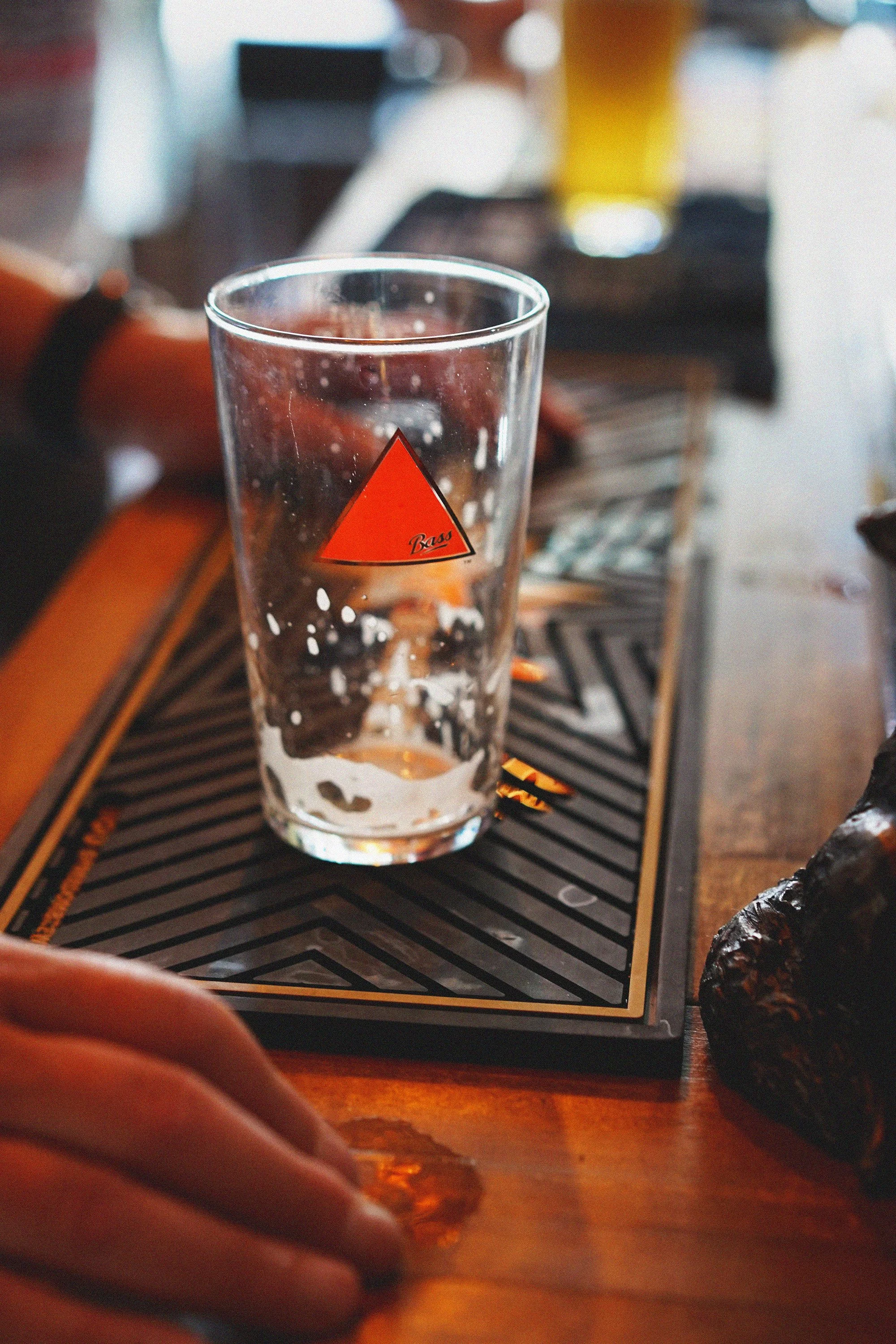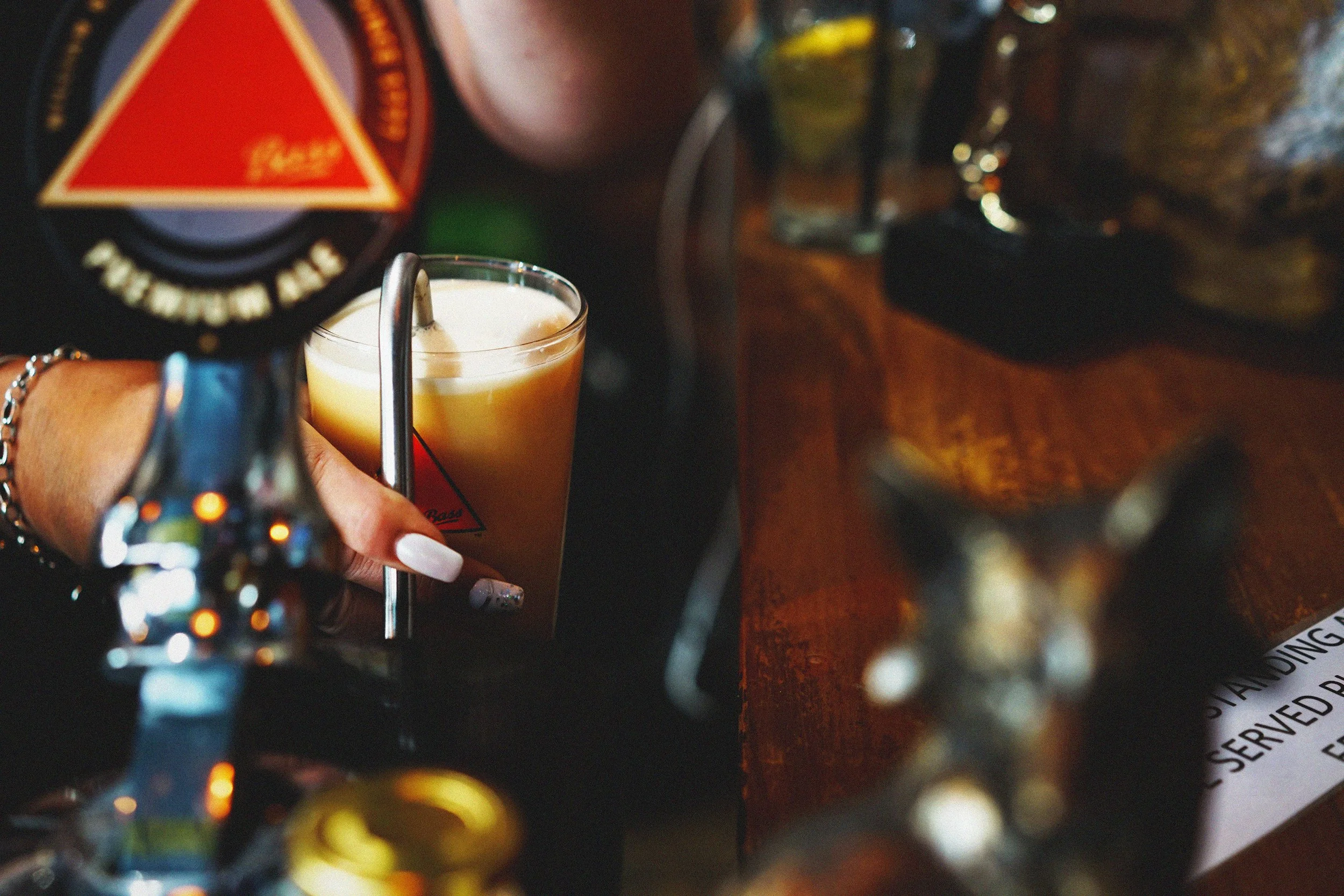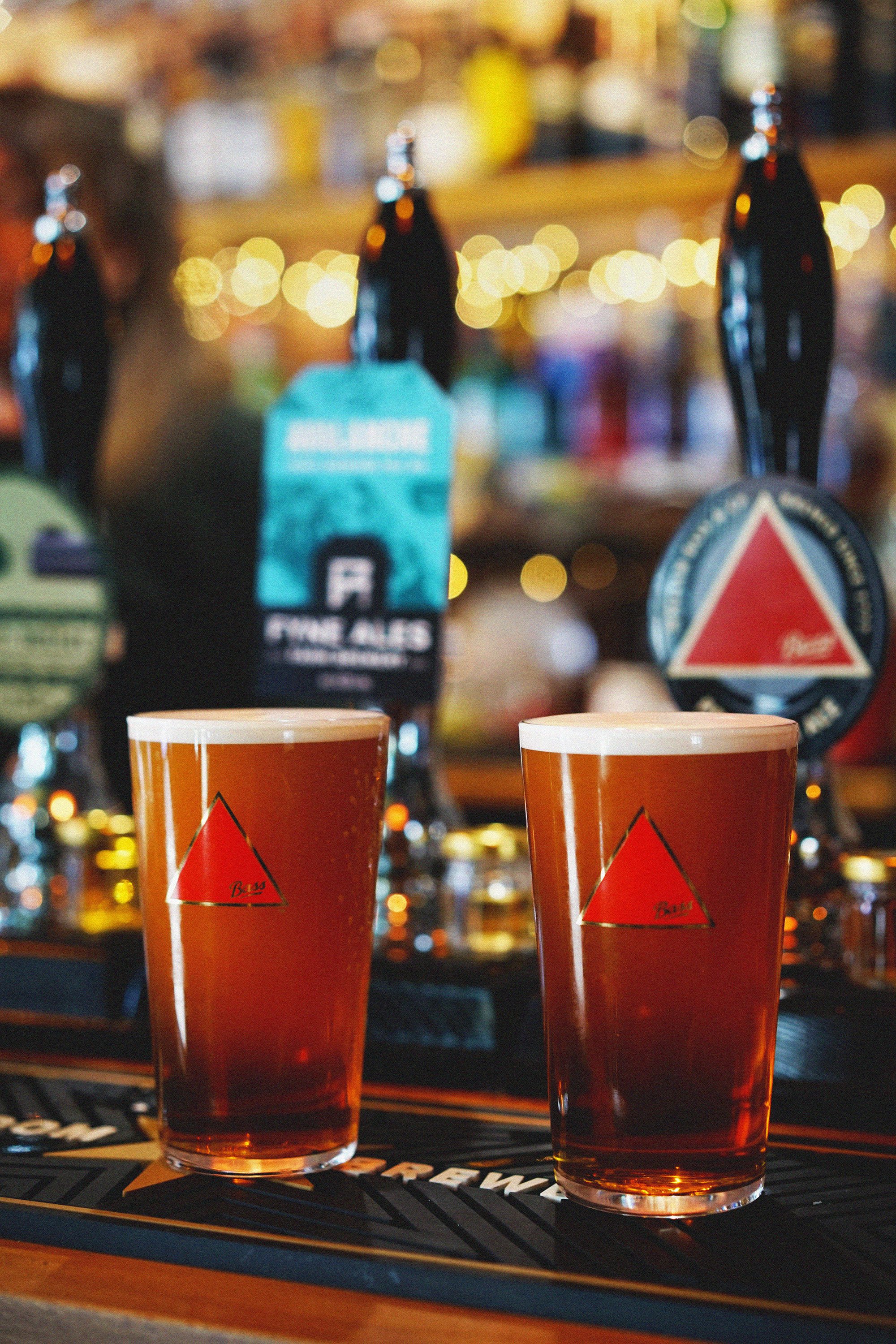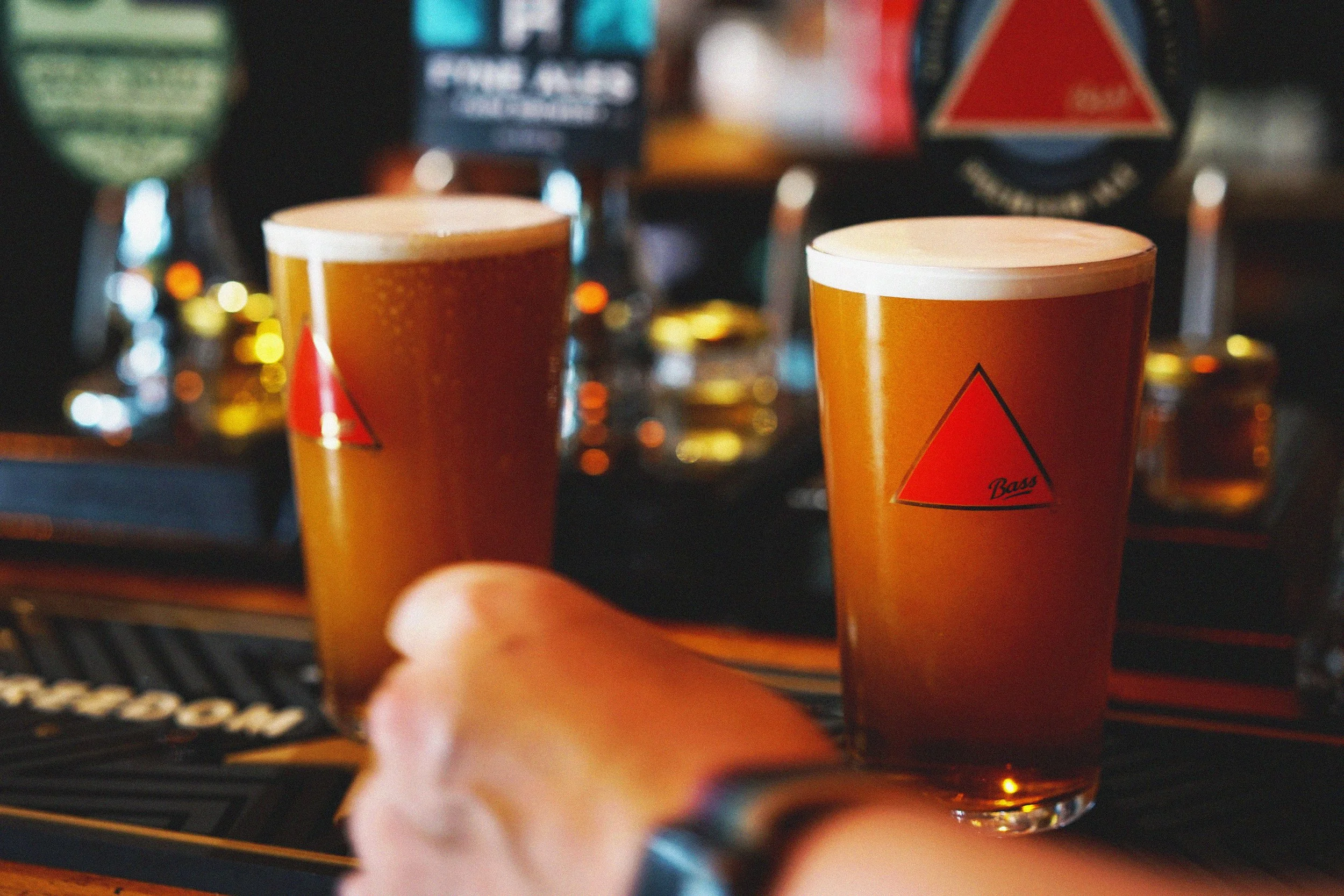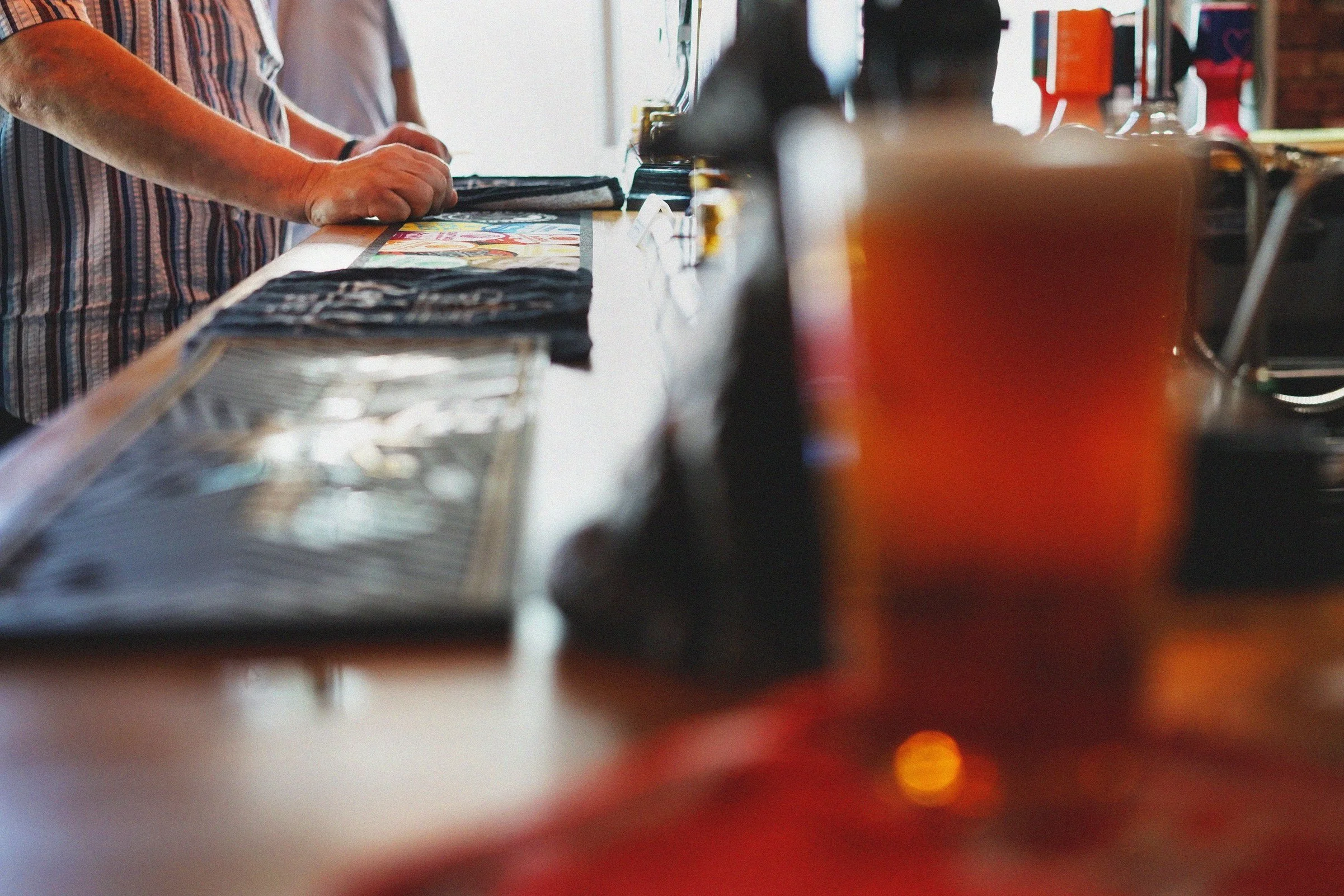No Treble — The Inextinguishable Appeal of Draught Bass
After dark, the Woolwich foot tunnel is a chilling prospect. For half a kilometre you hurry through a clinical, white-tiled tube under the Thames with no way of escape before emerging south-of-the-river.
That was the night I ate my first curry straight after drinking my first pints of Bass in a nearby pub. The latter was an essential lubricant, my mate, who was introducing me to both, had insisted.
Forty years on, this distant moment sprang into my mind as I rediscovered draught Bass at the Thorn Tree Inn on Matlock Bank, Derbyshire, where I had become a semi-regular. Here I would watch the red triangle’s peak pierce the altostratus clouds of lacing left by the luminous brown (never amber) liquid sinking down the branded glass.
Photography by Matthew Curtis
Bass is a beer that lodges in the mind. Its distinctive toffee-ish, nutty, subtly hopped Bass-ness triggers a chain reaction reaching deep into the memory, an organoleptic thread linking present with past, tying together my biography, my labile identity. If Bass is still Bass then I, in some sense, must still be me.
In between these two moments, while working on the Bass Brewers in-house newspaper during the 1990s, I’d drunk quite a lot of Draught Bass in Burton-upon-Trent, the Staffordshire town where its ancestor, one of the first IPAs, was born exactly 200 years ago, in 1823.
Still brewed in Burton, under contract by Marston’s, today’s Draught Bass bears little family resemblance. Probably not much more than that red triangle—trademark number one, as everyone knows, its simplicity recognisable enough, and compelling enough, to be featured in works of art by Manet and Picasso. You’d call it iconic if the word ‘iconic’ hadn’t become so devalued.
It should be an invaluable asset for any brand owner. Yet the global brewing company that’s lucky enough to have Bass in its stable, AB InBev, doesn’t seem interested. There was a rumour that it was up for sale—denied when I asked. What plans does AB InBev have for the brand, then?
““You’d call it iconic, if the word ‘iconic’ hadn’t become so devalued.””
“Bass, our much-loved and iconic golden ale, continues to be enjoyed by consumers across the UK,” came the bland reply. But hang on. “Golden ale”? Does it not know what Bass even is? Nor is it any longer “enjoyed across the UK”. That was last century.
***
Draught Bass is now a regional brand. A distribution map would look a bit like a tadpole with an outsize bulging head in the east Midlands—principally Staffordshire, Derbyshire and Leicestershire—and a thin tail snaking down into the West Country. Plus a scattering of frog spawn around Wales.
There is currently no Bass at all in the whole of East Anglia, and only one pub serving it in Sussex, Surrey and Kent—the Miners Arms in Sevenoaks.
We know all this because someone keeps track of the pubs pouring it. In 2018 Ian Thurman, concerned the beer would disappear, gathered a willing group of Bass lovers to report sightings around the country.
This crowdsourced research discovered that the number of pubs with Bass permanently on the pumps had fallen to a mere 350. A beer once drunk in thousands of pubs across the land was displaying all the symptoms of an endangered species.
To raise awareness and to boost sales, this group would, without any help from the brewer, organise a National Bass Day. Covid delayed its launch until 2022, Easter Saturday, and it was repeated on April 8 the following year. To generate even more publicity, Thurman’s lieutenant, brewing historian Ian Webster, organises a Best Bass in Burton contest for the local pubs.
The National Bass Day Facebook group has 1,700 members, who post pictures of the pint of Bass in front of them, and occasionally historic marketing materials they’ve found, all year round.
And that’s not the brand’s only dedicated consumer organisation. The Honourable Order of Bass Drinkers was founded in 1967 and is still meeting for pints, where they can find them, around North West England.
To some it might seem a strange obsession, but it reflects the deep emotions this beer taps into. Over a pint of Bass (what else) at the Flying Childers, close to his home in the Derbyshire Peaks, Ian Thurman talked about how much people care about this beer, and fear for its future. He was surprised at the support he got for his “madcap enterprise” to list every Bass pub, and that so many felt as he did.
A retired executive for a tech company, still with a youthful air about him, Thurman comes across as a thoughtful and level-headed sort of bloke, hardly given to madcappery.
Born into a Burton family, his grandfather a brewery labourer, he was prompted to act by the thought that he might one day have to explain to his grandchildren that Bass made beer, not mirrors if all that was left of it was on pub walls rather than on the pumps.
He is politely astonished that AB InBev fails to market Draught Bass and that the job has been left to drinkers like him. It’s a reluctant, but necessary, calling.
The brewery does do one thing, though. It provides pubs with branded glassware, a simple conical pint that best displays the dense white head, the lacing and the red triangle. It’s an essential part of the drinking experience, borne out by one Facebook member who had to travel for two hours to find a pint on National Bass Day—and took his own glass, to make sure.
Credit should also go to the publicans who continue to serve Draught Bass despite post-Covid supply issues. And there seems to be something special about a lot of Bass pubs.
A surprising number serve it straight from the cask, including perhaps the most famous Bass house, the Cooper’s Tavern in Burton, where the Bass brewing team from across the road used to escape at lunchtime. It’s now owned by Joule’s Brewery which was closed by Bass in 1974 and relaunched in 2010 by Steve Nuttall, a former Bass marketing man who came up with the idea of Caffrey’s before he saw the light.
““Perhaps Draught Bass, in a curious way, now belongs to its drinkers?””
At the Dyffryn Arms in Cwm Gwaun, Pembrokeshire, better known as Bessie’s, Bass is the only draught beer, poured from the cask into jugs, then into the glass, then through a hatch into the parlour.
The Sun Inn, Stockton-on-Tees, serves Draught Bass banked, as they like their ale on Teesside, with an airy, foam dome standing inches proud of the rim of the glass. While Bass pubs in Bristol, for some reason, pour it with no head at all.
The Express Tavern on the north side of Kew Bridge, meanwhile, is one of only three pubs in Greater London with Bass on permanently—and, apparently, it’s been on since the 1920s. There’s some splendid illuminated Bass signage across the front of the building, best viewed as you cross the bridge at night.
Joint holder of the Best Bass in Burton title, along with the Devonshire Arms around the corner, is the Roebuck Inn. A minute from the station, it’s the first stop for many pilgrims to the town on National Bass Day, including myself.
Zoe Poulton, the daughter of licensee Julie Latham, is behind the bar as the first devotees arrive at midday. The pub usually sells six to eight 10-gallon casks of Bass in a week. This weekend, though, she expected it to go up to four casks a day.
“We just can’t be without it,” she says. “When there was a supply problem last year we had to drive to Lincoln, a four-hour round trip, to pick some up.”
***
Here’s something strange about Draught Bass. It comes in 10-gallon casks rather than the standard nine-gallon firkins. Nobody seems to know why. It’s only been like that since Marston’s took over brewing it in 2005, but no one could tell me why.
There’s also a mystery around quality. The usual cellar management best practice applies, of course, and Zoe mentions “time in the cellar”, alluding to another peculiarity attributed to Draught Bass.
When I worked on the in-house paper the whispered trick was to keep it past its sell-by date before tapping the cask. I raised this with a group of former Bass employees who were also out in Burton’s pubs for National Bass Day, and they confirmed the extra time is needed to “round it off”.
Yet according to the brewery’s former quality director, Harry White, who worked for Bass for three decades from the 1970s, this is a myth.
It might be worth going into some history at this point to understand just what it is we’re drinking here.
Bass Pale Ale—it was never called an IPA—was first brewed in 1823, a year after Allsopp’s brewed the first commercial IPA, and by 1830 was outselling its rival, becoming popular at home as well as in the colonies.
Originally it would have been around 7% abv, but by the 1950s it had come down below 5% and, with some qualifications, became essentially the Draught Bass we’re drinking now.
Its listing in early editions of CAMRA’s Good Beer Guide has the strength as 3.9%, increasing to today’s 4.4% in 1977. However, brewing historian Ron Pattinson has compiled a set of analyses for Bass Pale Ale recipes from 1851 to 1994 that suggests efforts to maintain the draught product’s consistency over the past 80 years.
That’s allowing for the abandonment of Bass’s Burton Union brewing system in the late 1980s, the move to Marston’s and the introduction of various “efficiencies”, as Harry White describes them, meaning Draught Bass can never be quite the beer it once was. He especially mourns the loss of the ‘Burton snatch’, the whiff of sulphur that came from the local water.
And while Bass has gained a reputation for being ‘difficult to keep’, he recalls that brewers were focused on producing a cask beer that reduced the risk of pubs serving a bad pint.
“In part, we always felt the robustness of Bass was due to it being fermented with two yeast strains, so there was little, if any, fermentable residue remaining by the time the cask was tapped,” White says. Giving it more time in the cellar, therefore, cannot have much of an impact.
No doubt the debates will continue, and that’s all part of the mythology of Draught Bass, part of its fascination.
But is there a future for Bass? It has to be admitted that the people who drink it are getting on a bit—and I include myself in that. Ruthless marketers have a category for that—milk brands. They will be milked until, like an old soldier, they simply fade away.
Should we care? Wouldn’t ink be better spilt on those creative, independent breweries that are having such a tough time these days? Why bother about an old-fashioned ale from a global brewer?
It’s a good point. But what if that beer has wriggled loose of its corporate constraints? Perhaps Draught Bass, in a curious way, now belongs to its drinkers? Perhaps, by some strange twist, it’s become exactly the thing we’ve all been searching for: a free beer.
***
If you are inspired by this feature to seek a pint of Draught Bass, check out the regularly updated list of pubs that carry it courtesy of this list compiled by Ian Thurman. Scroll down the post to find the link, which is updated regularly.
















